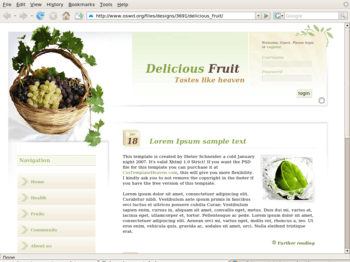Web Design/Dynamic Websites/Creating Database Tables
< Web Design < Dynamic Websites|
Web Design → Creating Database Tables
|
Before we can start using databases to create dynamic sites, we first need to create a database table! Since most cheap hosting sites support MySQL as their database server, we're going to use a special program that's been written by someone else to help us setup and administer our MySQL databases... it's called PhpMyAdmin.
From the PhpMyAdmin homepage:
phpMyAdmin is a tool written in PHP intended to handle the administration of MySQL over the Web. Currently it can create and drop databases, create/drop/alter tables, delete/edit/add fields, execute any SQL statement, manage keys on fields, manage privileges,export data into various formats and is available in 50 languages.
To take part in this activity, you'll need to know:
- the URL of your database host, as well as your database username and password. If you are unsure about these, ask your hosting company or your facilitator.
- Alternatively, you can install XAMPP Lite or WampServer on your local computer as it has PhpMyAdmin already installed for you.
Getting aquainted with PhpMyAdmin
To start getting aquainted, there's a nice and simple PhpMyAdmin Tutorial that will get you started creating your first example table using PhpMyAdmin, and inserting data into it. Try it out and see how you find the experience!
After finishing the tutorial, you might like to reflect on your blog or elsewhere:
- Describe why database tables usually have one field set as the primary key?
- How is the Auto Increment option useful?,
- When adding a field to a database, what other information do we need to specify?
Creating your own table
Once you've finished with the example, we're ready to create our own database table! Referring back to an HTML form that you have created in the past (one that collects information from users, say for purchasing a product):
- write down the fields that will require to store this information in a database.
- Using PhpMyAdmin, create a new table in your database with a meaningful title (relevant to the data you're collecting, such as orders or enquiries etc)
- Specify the fields that you require to store your data (making sure that you choose the correct type, and that you've created a primary key etc).
- Insert 4 or 5 lines of sample data to your new table, each time noting the actual SQL code that is being used to add the information into your database.
More on Database Types
To re-cap some and pull together some of the things you've learned so far, read through Using MySQL down to (but not including unless you're keen) the Basic SQL Statement.
For the moment, it's important that you:
- Feel comfortable creating a new table in a database using PhpMyAdmin,
- Correctly select the type for each field in your table using only the simple types (e.g. int, text, varchar, datetime, but you should be aware that there's lots of other types),
- Create a primary key for each table and use the auto-increment option correctly,
- Have a vague idea of what an SQL statement looks like (more on this later!)
Phew! Enough for one day?! Next, we'll be finding out how we can connect to our database from PHP!
HTML: What is HTML, Advanced HTML Tutorial, HTML Challenges, Lists and Tables, The Structure of HTML, Pen and Paper HTML activities
CSS: Learning Basic HTML and CSS, CSS challenges, Embedded CSS, Basic HTML and CSS Tutorial, Inline CSS, Develop cascading style sheets, CSS3 Animations
PHP: Simple functions in PHP, Dynamic websites, PHP challenges, Dynamic websites with PHP, Generating a receipt with PHP, Responding to HTML forms with PHP,
JavaScript: An Introduction to Programming with JavaScript, JavaScript Challenges, Getting to know JavaScript events, Getting to know the Document Object Model with JavaScript, JavaScript pen-n-paper activities, Web Programming Intro, Produce basic client side script for dynamic web pages
XML: XML challenges
Databases: Creating Database Tables
Projects: A small website project, A step-by-step web design project, Build a basic web page, Build a small website
Challenges: Web design, HTML, AJAX, CSS, JavaScript, PHP, XML, Information Architecture, Algorithms
Activities: Web design group learning activities, Pen and Paper HTML activities, A Web Design Quiz show, Ordering Tasks for a Web Project, Paired Bio Pages, Scoping a Small Project, Emerging Technologies Research Activities
Project management: An introduction to Project Management, Developing a Client Project
Design: Accessibility, Design Principles for Web Design, Design Suggestions
Testing: Testing Website performance, Website Performance Test Plan
Publishing: Getting Your Site On the Web
Certification and standards: Cert IV Website Qualifications in Australia, Australian Qualifications, Web design qualifications
Professional development: Contribute to personal skill development and learning, Useful Applications, Useful Books, Emerging Technologies, Using the Internet as a Learning Tool
Course meta-information: Web Design, About the web design learning project, New Structure, Sample Timetable

